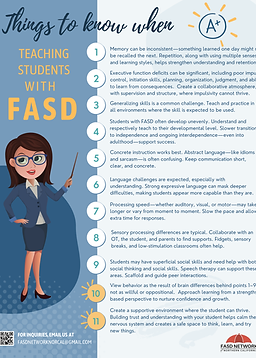FAST FACTS
-
FASD is more common than Autism. Between 2 to 5% of every 1st-grade child in the United States has this complex, neurodevelopmental disorder. In California, the prevalence was close to 5%.
-
Alcohol is a poison to the developing brain inutero.
-
FASD is the most common known cause of intellectual disability in the United States, however, 75% of affected people have typical IQ.
-
Most affected children have an invisible disability with no outward sign of a disorder.
-
Fetal Alcohol Spectrum Disorder is a physical disability - brain damage. It is lifelong.
-
Most children and youth with FASD have complex learning, behavior and social difficulties affecting all aspects of the school experience.
1
May, PA. Th Prevalence of Fetal Alcohol Spectrum Disorders in 4 US Communities. JAMA, 2018;319(5):474 482. doi:10.1001/jama.2017.21896
1
What a teacher might see in a classroom
-
Executive function deficits that can be severe: poor impulse control, planning, organization, judgment, and ability to learn from consequences.
-
Slow processing speed
-
Significant memory deficits
-
Language deficits, especially for language understanding. Expressive language may be their highest skill making the child look good
-
Concrete thinkers
-
Fine motor deficits
-
Visual-spatial deficits
-
Sensory overwhelm
-
Meltdowns
-
Adaptive functioning lower than what is expected by IQ
-
Poor peer relationships - social communication deficit
-
Superficial engagement with work

FASD and Special Education
Many children with FASD should qualify for special education. However, the disorder is not named as a category for special education eligibility. As of January 1, 2023, in California, FASD is now named as a medical condition that would qualify a child under the category of Other Health Impaired.
The prevalence of FASD is higher in Special Education. In Canada, research indicated that the prevalence is nine times higher than the general population. Children in foster care, adoption and in the criminal justice system also show a much higher occurrence of FASD.
Early identification and intervention are critical to a better outcome in adulthood, yet most children with FASD are misdiagnosed or undiagnosed. Special education is also a protective factor for this population. We can and should do better.

FASD is said to be an invisible disability, and as such, standard evaluations may not catch the full struggle. Below are some typical assessments that are important to consider when making an assessment plan.
-
Adaptive Functioning
-
Executive Functioning
-
Processing Speed
-
Memory
-
Sensory Integration
-
Social Communication
-
Visual-Spatial
-
Motor Skills
Assessing a Child for an IEP when FASD is suspected
Brain not Blame
Fetal Alcohol Spectrum Disorder is permanent brain damage. However, affected children can and do succeed, based on the response of the adults around them.
A paradigm shift is needed.
The shift in thinking begins with focusing on the brain of a child with FASD and not the behavior. Understanding that the child may not be able to do what is asked, which is different than won't even though it may appear as a refusal. Children with this disorder are often blamed for what they cannot do because the brain damage is not recognized. Affected children have a physical disability. Teaching children with FASD requires first recognizing the brain basis, much of which looks like behavior, and then changing the environment and teaching techniques to match the learning/behavior profile of the child.
1. Supervision: Especially during unstructured times such as recess and lunch
2. Routine
3. Structure
4. Repetition (in teaching)
5. Concrete: Recognize difficulty in abstract thinking
6. Consistency
7. Specificity: Say exactly what you mean and what you want the child to do
8. Simplicity: Keep it short and sweet

Fetal Alcohol Spectrum Disorder
A Common but Misunderstood Developmental Disability with a Large Impact on California's Educational System
-
Approximately 6 million children are enrolled in public education in California.
-
It is estimated that between 240,000 to 300,000 of those children will have an FASD.


-13.png)

